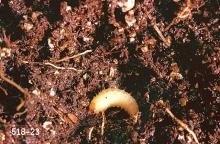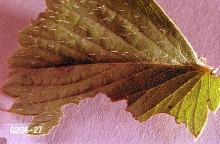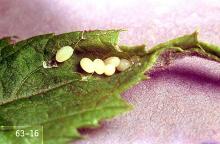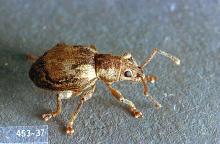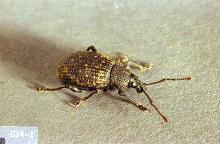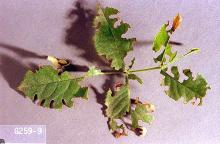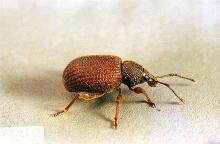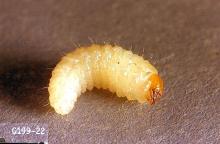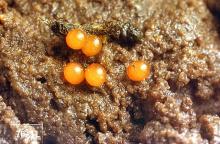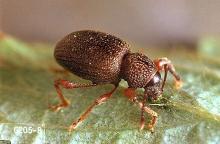Pest Description and Damage Black vine weevil is not always the most common weevil to infest landscape plants. In several landscapes in Oregon, the strawberry root weevil and obscure root weevil were dominant, and in Washington often the clay-colored weevil and species of the native woods weevils are the dominant species in many landscapes. Other species are also present in PNW states (see below). In Washington there are 16 species that have been found on a variety of plants in landscapes. In Oregon, there are several additional species, including Plinthodes tineatus and Otiorhynchus décoratus.
It is important to identify the species of root weevil infesting plants (see descriptions below) because of variations in life cycle and susceptibility to pesticides. In the early 1970s, this handbook recommended aldrin, dieldrin, heptachlor and chlordane for the introduced weevils, and malathion and diazinon for native woods weevils.
Adult weevils are small dark beetles with a snout (rostrum) and elbowed antennae. They cannot fly so distribution is through migration or movement of infested pots, soil or debris. Also, the adults of most of the species are all females and capable of laying eggs after a period of feeding to mature their ovaries. They are slow moving and should not be confused with swifter predacious ground beetles. Larvae, found around roots, are C-shaped, legless, and white with tan heads, up to 0.5 inch in size. All species are quite similar in appearance and habits of feeding on root hairs, larger roots and root crown. Adult weevils are night feeders that mostly remain in the soil or in debris at the base of the plant during the day, then climb up to feed on leaves at night. Look for ragged notches on the edges of leaves, or flower petals.
Black Vine Weevil (Otiorhynchus sulcatus)-One of our largest root weevils (8-11 mm), this species is black with yellow patches of hairs and smooth rounded tubercles on the thorax. Weevils overwinter as larvae in the soil and adults emerge in early June. A few adults are active in winter months in milder climates. In June, larvae pupate, and adults emerge. Eggs are laid singly or in small clusters in or on the soil from June to September.
Strawberry root weevil (Otiorhynchs ovatus)-This 4-6 mm, reddish-black to black, shiny weevil has reddish legs; it appears smooth but on magnification has small hairs and pits. Adults emerge in mid June but some overwinter in warmer climates.
Barypeithes pellucidus-One of the smallest weevils (2-4 mm), this weevil looks like a tiny strawberry root weevil but is thinner in the side profile and has a soft "down" hairs; one of the few root weevils with males and females (often in copula).
Lilac or privet weevil (Otiorhynchus merdionalis)-This weevil is the most common species in eastern Washington and known from collections in E. Oregon. It is 8-9 mm with both males and larger females (often found in copula). They appear uniformly blackish and shiny.
Rough strawberry root weevil (Otiorhynchus rugosstriatus)-This species is 6-8.5 mm, and a uniformly a dark mahogany color (reddish brown) with a "matte finish" It is distinguishable by the squared shape of the elytra when viewed from above and short stiff hairs (just barely visible in the outline of the elytra).
Clay colored weevil (Otiorhynchus sngularis) -This species is one of the most numerous in W. Washington landscapes. It is 6-9 mm, mottled brown (tan and brown scales) with scales on legs; there are no hairs on elytra or thorax, the underside is shiny dark brown. It is the earliest to emerge in spring, often in April.
Otiorhyncu raucus-This recent arrival in Oregon and Washington looks slightly shorter and broader than clay colored weevil, overall light brown with a darker thorax. The thorax has fine setae; underside dull brown rather than shiny beneath. Emerges in early spring.
Dark-eyed weevil (Sciaphilus speratus)-Another relative newcomer to landscapes, this slightly iridescent golden weevil has a distinctive dark eyes and dark stripe across the elytra.
Nut leaf weevil (Strophosoma melaogrammum)-This 4.5-6 mm weevil is a relative newcomer to landscapes. It is slightly iridescent with coppery-brown scales and a distinctive partial dorsal stripe between the elytra. It is a voracious feeder with a somewhat distinctive feeding pattern, often a "maze" of channels from the leaf edge. It is most commonly found in the fall and spring.
Obscure root weevil (Sciopithes obscurus)-This native species is diurnal and is more abundant in wooded areas, and in Oregon. It is 3-6.6 mm, is grayish with brown markings with a distinctive V-shaped line at the declivity (rump).
Grass weevil, crusted grass weevil (Trachyphloeus bifoveolatus)-This tiny 3-4 mm gray-brown weevil occurs but not commonly in landscapes. It enters houses in large numbers in fall in pastoral areas.
Woods weevil (Nemocestes incomptus)-This 6-9 mm native species is sooty dark brown to blackish color with a light band on the side of the thorax and elytra; it covered with short hairs on thorax and elytra. Adults emerge in late summer with numbers peaking in fall. They can feed throughout the winter months in warmer areas.
Horn's woods weevil (Nemocestes horni)-This native species is easily mistaken for woods weevil but is slightly smaller (5-8 mm) with some lighter streaks.
Small woods weevil (Nemocestes montanus)-A smaller (4-5 mm) version of the woods weevil still has the light stripe on the thorax and elytra. Common and occasionally abundant.
Woodburn weevil (Dyslobus (syn. Lepesoma) granicollis)-This large native weevil 7-9 mm is found in low numbers especially near wooded areas.
Biology and life history Adults of most species are abundant from through May through September (black vine weevil, strawberry root weevil, rough strawberry root weevil, clay-colored weevil, lilac weevil, woodburn weevil, Barypiethes pullucidus, obscure root weevil). Weevils overwinter as larvae in the soil. Feeding may occur throughout mild winters. In April to June, larvae pupate, and adult emergence occurs. Adults are night feeders that remain in the soil or in debris at the base of the plant during the day, then climb up to feed on leaves. Adult weevils cannot fly, but walk or are carried from one location to another. Also, all adults are females capable of laying eggs. Adults are slow moving and should not be confused with swifter predacious ground beetles. Eggs are laid in clusters in or on the soil from June to September. The eggs hatch, and the larvae immediately wriggle through the soil to begin feeding. There is one generation per year.
The woods weevils, nut leaf weevil, grass weevil and Sciaphilus asperatus emerge in late summer and are active through the winter and very early in spring. Larvae of the fall emerging species are likely to be present during the summer months.
Scouting and thresholds Observe leaves for first signs of notching in early summer (primroses are an inexpensive preferred host and can be used as an indicator plant for conifer field production. Confirm presence of adults by night inspection of foliage on warm, still evenings. Or, look for adults by day in debris at the base of the plant. Laying a small piece of cardboard at the base of the plant provides a refuge that you can check easily in the early morning. Commercial root weevil traps are available. Inspect the pots of plants by tapping the plant out of the pot, and check for areas of missing roots on the sides and bottom of the pot or for small white, C-shaped grubs. Remove these before planting. If there is evidence weevil have been feeding on root hairs, moved into the rootball it is wise to shake off all soil into a bucket before planting to remove larvae feeding inside the root ball, on larger roots or the root crown. Clean up crossing, kinked roots at the same time.
Management-biological control
See also:
Biological Control of Nursery Pests
Management-chemical control
See also:
Chemical Control of Nursery Pests
Begin adult control when adults emerge in late May and June. Control larvae in the fall. Overwintering adult weevils can lay eggs without the pre-ovipositional feeding interval. Research in strawberries has shown around 25% of black vine weevil adults overwintered successfully. In mild years, growers may need to target these weevils earlier, in April and May, in order to achieve satisfactory weevil management.
For more information
Johnson, W.T. and H.H. Lyon (1991), Insects That Feed on Trees and Shrubs, 2nd ed., Cornell University Press (p. 240-243).
Biocontrol of Root Weevils (https://agsci.oregonstate.edu/nurspest/insects/biocontrol-root-weevils)
Western Washington Field Guide to Common Small Fruit Root Weevils (https://pubs.extension.wsu.edu/western-washington-field-guide-to-common-small-fruit-root-weevils)
Proceedings of the North American Root Weevil Workshop. SR 1065 (https://hdl.handle.net/1957/8262)

